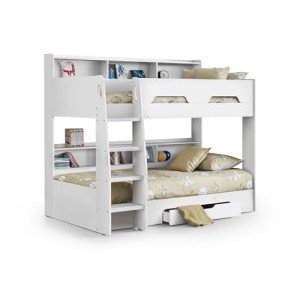
The Ultimate Guide to Bunk Beds for Kids: Safety, Styles, and Solutions
Bunk beds have long been a popular option amongst parents seeking to enhance space in their children's bed rooms. With benefits that go beyond their compact style, bunk beds provide an enjoyable and practical sleeping arrangement while encouraging sibling bonding and promoting creativity. In this thorough guide, we explore different elements of bunk beds for kids, consisting of safety factors to consider, different designs available, and suggestions for picking the ideal one for your household.
Why Choose Bunk Beds?
Bunk beds are developed to stack one bed on top of another, making use of vertical space to create more space for play and storage. They are particularly helpful for households with several kids or restricted bedroom space. Additionally, they provide an adventurous sleeping environment that children typically delight in.
Secret Advantages of Bunk Beds:
- Space-saving design: Ideal for small spaces or shared areas.
- Economical: Often more budget-friendly than purchasing 2 separate beds.
- Motivates social interaction: Promotes bonding amongst siblings or good friends.
- Versatile choices: Available in various styles and setups to suit any room design.
Safety First: Essential Considerations
When choosing a bunk bed for kids, security needs to be the leading priority. The following features are crucial for guaranteeing a protected sleeping environment:
Important Safety Features:
- Sturdy Construction: Ensure that the bed frame is made from resilient materials such as solid wood or metal.
- Guardrails: Bunk beds need to have guardrails on both sides of the upper bunk to prevent falls.
- Ladder Safety: A strong, built-in ladder or stairs with anti-slip rungs is important for safe access to the top bunk.
- Weight Limit: Check the maker's weight limit capacity for both the leading and bottom bunk.
- Bed mattress Size: Use the right mattress size as specified by the bed producer to make sure a snug fit within the bed frame.
Security Tips for Parents:
- Monitor Sleep Habits: Teach children the importance of not using or jumping off the bunk beds.
- Age Appropriateness: Generally, the upper bunk is appropriate for kids aged 6 and older.
- Routine Inspections: Periodically check for any loose bolts, screws, or structural damage.
Styles of Bunk Beds
Bunk beds come in a variety of designs, allowing parents to pick one that complements their child's room decor while conference specific requirements. Below are some popular styles:
Popular Bunk Bed Styles:
- Traditional Bunk Beds: Simple and timeless designs made from wood or metal without any extra features.
- Loft Beds: Features a raised leading bunk with space underneath for a desk, play area, or additional storage.
- L-Shaped Bunk Beds: Arranged in an L-shape, frequently perfect for corner areas and can have additional storage options.
- Twin over Full Bunk Beds: A twin bed on top and a bigger full-sized bed on the bottom, accommodating children or teens of various ages.
- Triple Bunk Beds: Designed to fit three beds in a single footprint, suitable for larger families or pajama parties.
A Comparison of Bunk Bed Styles
| Bunk Bed Style | Description | Best For |
|---|---|---|
| Standard | Traditional style with 2 stacked beds | Requirement bedroom setups |
| Loft Bed | Raised bed with usable space underneath | Homework or play areas |
| L-Shaped | Bunk beds arranged in an L-shape | Corner spaces |
| Twin over Full | Twin bed on top, complete bed below | Different age brother or sisters |
| Triple Bunk | Three stacked beds | Large households or pajama parties |
Choosing the Right Bunk Bed
When searching for the ideal bunk bed, consider the following elements to guarantee you make a notified decision:
Key Factors to Consider:
- Room Size: Measure the room measurements to figure out the proper size and height of the bunk bed.
- Child's Age: Consider the age of your kid(ren) when picking a design and safety features.
- Functionality: Think about how much storage or play space you require and whether the bunk bed need to serve extra functions.
- Budget: Set a budget plan that includes not only the bunk bed but likewise the required mattress and devices like bedding or safety gates.
FAQs About Bunk Beds for Kids
1. What age is appropriate for a kid to oversleep the leading bunk?
Usually, kids aged 6 and older should have the ability to securely sleep in the top bunk, though you must constantly consider your kid's maturity level.
2. Are bunk beds safe for toddlers?
It is not suggested for young children or really young kids to oversleep the leading bunk due to the risk of falling.
3. How do I preserve the bunk bed?
Check the bed regularly for any indications of wear and tear, tightening up screws, and cleaning up the bed mattress to make sure extended safety and durability.
4. Can I transform a bunk bed into 2 different beds?
Many bunk beds are developed to be convertible, enabling you to separate the beds when required. Inspect the producer's requirements before purchasing.

5. How can I make the most of space in a bunk bed space?
Utilize under-bed drawers, shelves, or lofted styles to develop extra storage options in a space with a bunk bed.
Bunk beds provide a delightful mix of enjoyable, performance, and space-saving energy, making them an ideal choice for young families. By thinking about security functions, numerous designs, and useful elements such as space size and age appropriateness, moms and dads can choose the best bunk bed for their kid's needs. With the ideal choice, bunk beds can transform a bedroom into a wonderful space that motivates play, creativity, and bonding amongst brother or sisters. Constantly remember to focus on security and maintenance to make the most of this special sleeping arrangement.




